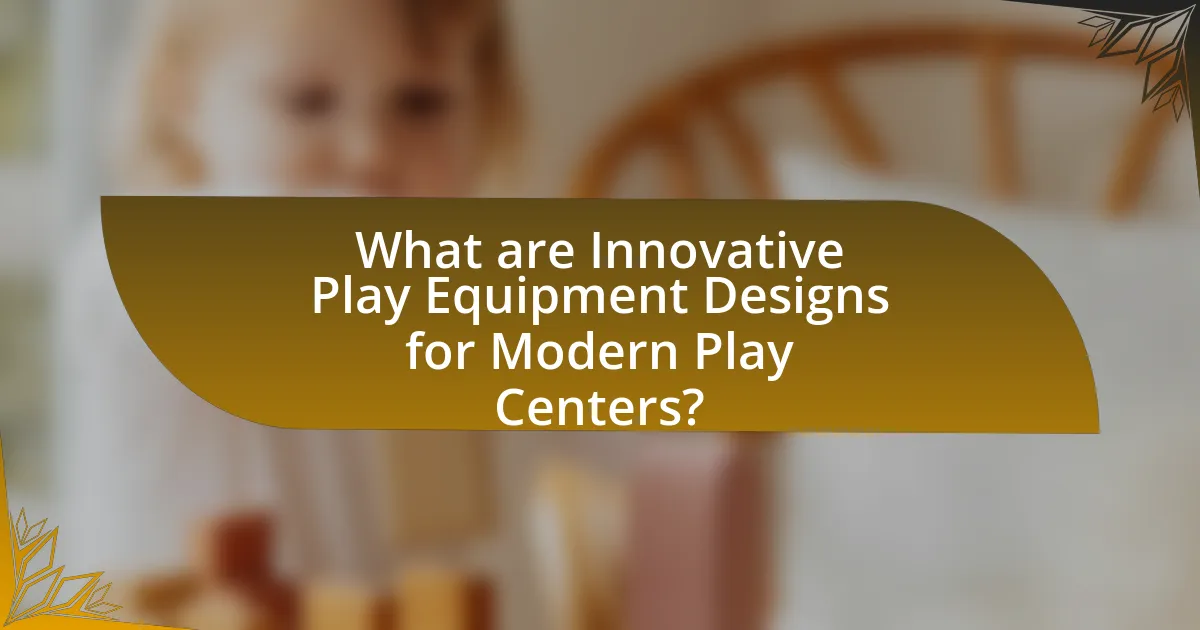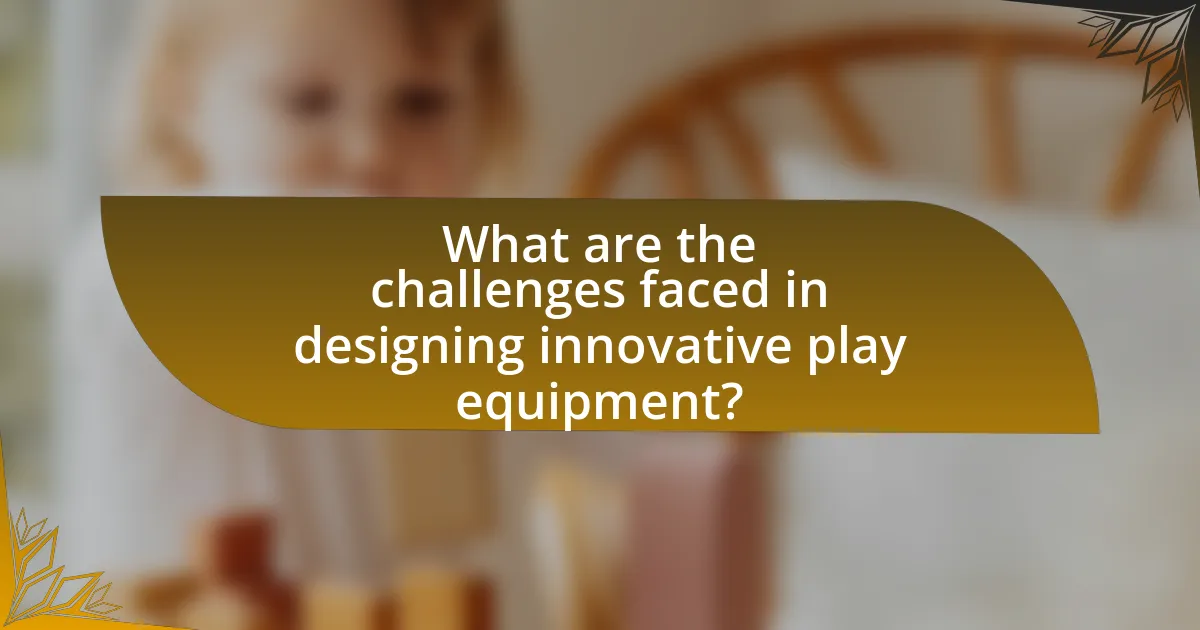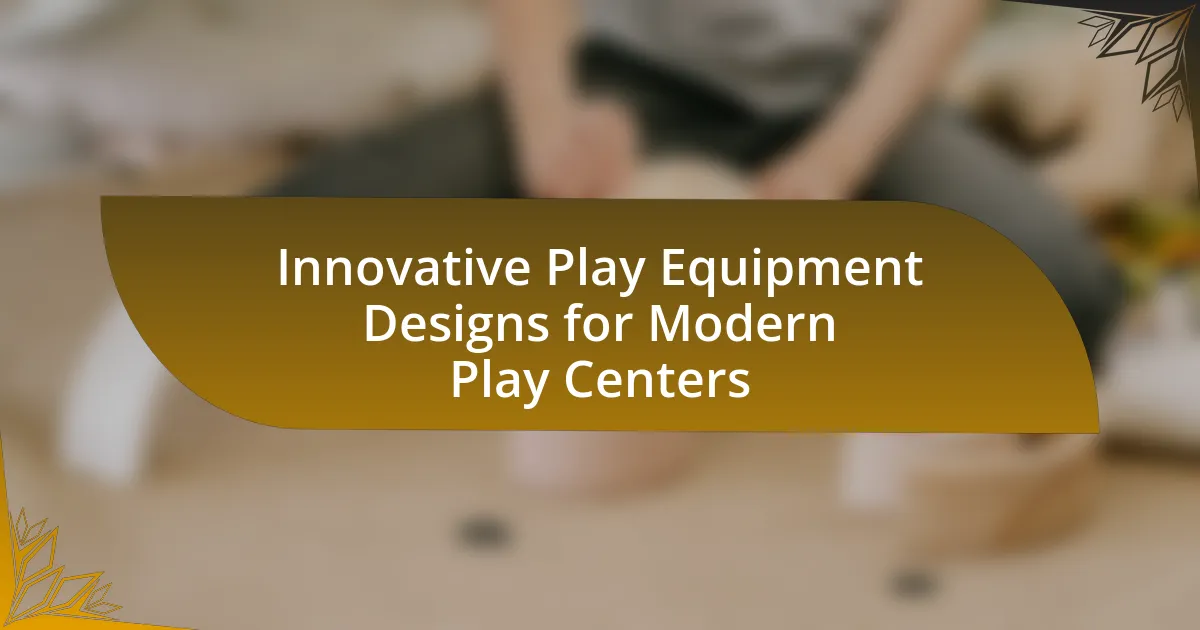Innovative play equipment designs for modern play centers focus on enhancing physical activity, cognitive development, and inclusivity through interactive structures, sensory panels, and modular systems. These designs differ from traditional equipment by promoting social interaction and safety, utilizing materials like recycled plastics and metals. Safety standards significantly influence design choices, ensuring compliance and minimizing injury risks. The article explores the benefits of innovative designs for child development, the integration of technology, and emerging trends shaping the future of play equipment, while addressing challenges such as budget constraints and regulatory hurdles.

What are Innovative Play Equipment Designs for Modern Play Centers?
Innovative play equipment designs for modern play centers include interactive climbing structures, sensory play panels, and modular play systems. These designs enhance physical activity and cognitive development by incorporating elements like slides, ropes, and balance beams that encourage exploration and social interaction. For example, interactive climbing structures often feature varying heights and textures, promoting gross motor skills and risk assessment in children. Sensory play panels engage multiple senses, aiding in sensory processing and fine motor skills development. Modular play systems allow for customizable configurations, adapting to different age groups and play styles, which has been shown to increase engagement and usage rates in play centers.
How do these designs differ from traditional play equipment?
Innovative play equipment designs differ from traditional play equipment primarily in their focus on inclusivity, interactivity, and safety. Traditional play equipment often emphasizes static structures like swings and slides, while modern designs incorporate elements that encourage social interaction, sensory experiences, and physical challenges. For example, many contemporary designs feature adaptive components that accommodate children of all abilities, promoting inclusivity. Additionally, innovative equipment often utilizes materials and technologies that enhance safety, such as soft surfaces and rounded edges, reducing the risk of injury compared to older, more rigid designs. These advancements reflect a shift towards creating engaging, safe, and accessible play environments that cater to diverse needs and preferences.
What materials are commonly used in innovative play equipment?
Innovative play equipment commonly utilizes materials such as recycled plastics, metal, wood, and composite materials. Recycled plastics are favored for their durability and environmental benefits, as they reduce waste and can withstand various weather conditions. Metal, particularly stainless steel and aluminum, is often used for structural components due to its strength and longevity. Wood, especially treated varieties like cedar or redwood, is popular for its natural aesthetic and safety features. Composite materials, which combine different substances, are increasingly used for their versatility and ability to mimic natural textures while providing enhanced safety and durability. These materials are selected based on their performance, safety standards, and sustainability, ensuring that modern play centers can offer engaging and safe environments for children.
How do safety standards influence design choices?
Safety standards significantly influence design choices by mandating specific criteria that ensure the well-being of users. For instance, in the context of innovative play equipment for modern play centers, these standards dictate materials, structural integrity, and user accessibility. Compliance with safety regulations, such as those set by the American Society for Testing and Materials (ASTM) and the Consumer Product Safety Commission (CPSC), requires designers to incorporate features like rounded edges, non-toxic materials, and adequate fall zones. This adherence not only minimizes the risk of injury but also enhances the overall user experience, as safe designs encourage more active and confident play.
Why is innovation important in play equipment design?
Innovation is important in play equipment design because it enhances safety, engagement, and developmental benefits for children. Modern play equipment must adapt to evolving safety standards and incorporate materials and technologies that minimize injury risks. For instance, the introduction of soft-fall surfaces and modular designs has significantly reduced accidents in playgrounds. Additionally, innovative designs promote physical activity and cognitive development by offering diverse play experiences, such as interactive elements that stimulate problem-solving and social skills. Research indicates that children are more likely to engage in active play when equipment is creatively designed, leading to improved physical health outcomes. Thus, innovation in play equipment design is crucial for creating safe, engaging, and developmentally beneficial play environments.
What benefits do innovative designs provide for child development?
Innovative designs in play equipment significantly enhance child development by promoting physical, cognitive, and social skills. These designs often incorporate interactive elements that encourage active play, which is essential for developing motor skills and coordination. For instance, research from the American Academy of Pediatrics indicates that active play contributes to healthier weight management and improved cardiovascular fitness in children. Additionally, innovative designs often include problem-solving features that stimulate cognitive development, as children engage in imaginative play and critical thinking. Furthermore, these designs facilitate social interaction among peers, fostering communication and teamwork skills, which are crucial for emotional and social growth.
How do modern designs enhance user engagement and enjoyment?
Modern designs enhance user engagement and enjoyment by incorporating interactive elements, vibrant aesthetics, and user-centered functionality. These designs often feature sensory-rich materials and technology integration, such as augmented reality, which captivates users and encourages exploration. For instance, studies show that play equipment with varied textures and colors can increase children’s playtime by up to 30%, fostering longer engagement. Additionally, designs that promote social interaction, like collaborative play structures, have been linked to improved social skills and enjoyment among users.

What trends are shaping the future of play equipment design?
The future of play equipment design is being shaped by trends such as inclusivity, sustainability, and technology integration. Inclusivity ensures that play spaces cater to children of all abilities, promoting social interaction and accessibility. For instance, the design of equipment like wheelchair-accessible swings and sensory play panels is becoming more common, reflecting a commitment to diverse user needs. Sustainability is driving the use of eco-friendly materials and energy-efficient designs, with manufacturers increasingly opting for recycled plastics and natural materials to minimize environmental impact. Additionally, technology integration, including interactive digital elements and augmented reality features, enhances engagement and learning opportunities in play environments. These trends are supported by research indicating that inclusive and sustainable designs not only improve user experience but also foster community well-being and environmental responsibility.
How is technology integrated into modern play equipment?
Technology is integrated into modern play equipment through the incorporation of interactive elements, digital interfaces, and smart features that enhance the play experience. For example, many playgrounds now include equipment with touchscreens, augmented reality (AR) games, and sensors that respond to children’s movements, promoting active engagement and learning. Research indicates that play equipment with technology can improve cognitive skills and social interaction among children, as seen in studies conducted by the University of Illinois, which found that interactive play promotes teamwork and problem-solving abilities.
What role do interactive elements play in enhancing play experiences?
Interactive elements significantly enhance play experiences by fostering engagement and promoting active participation. These elements, such as touchscreens, motion sensors, and collaborative games, encourage children to explore, learn, and socialize, thereby enriching their playtime. Research indicates that play environments incorporating interactive features lead to increased physical activity and cognitive development, as children are more likely to experiment and interact with their surroundings. For instance, a study published in the Journal of Play and Development found that children in interactive play settings demonstrated improved problem-solving skills and social interactions compared to those in traditional play environments.
How are sustainability practices influencing design choices?
Sustainability practices are significantly influencing design choices by prioritizing eco-friendly materials and energy-efficient processes in the creation of play equipment. Designers are increasingly opting for recycled materials, such as reclaimed wood and recycled plastics, which reduce environmental impact and promote resource conservation. For instance, a study by the American Society of Landscape Architects found that using sustainable materials can lower carbon footprints by up to 30%. Additionally, the integration of renewable energy sources, like solar panels, into play equipment designs enhances energy efficiency and reduces operational costs. This shift towards sustainability not only meets regulatory requirements but also aligns with consumer demand for environmentally responsible products, ultimately shaping the future of innovative play equipment designs in modern play centers.
What are the key features of successful modern play centers?
Successful modern play centers feature inclusive design, safety, and diverse play options. Inclusive design ensures accessibility for children of all abilities, promoting social interaction and engagement. Safety is paramount, with equipment constructed from durable, non-toxic materials and designed to minimize injury risks. Diverse play options, including physical, imaginative, and sensory activities, cater to various developmental needs and preferences, fostering creativity and physical fitness. Research indicates that play centers incorporating these features see increased usage and positive developmental outcomes for children.
How does layout and space utilization affect play center design?
Layout and space utilization significantly influence play center design by determining the flow, accessibility, and safety of the environment. A well-planned layout maximizes the use of available space, allowing for diverse play areas that cater to various age groups and activities. For instance, research indicates that play centers designed with open spaces and clear sightlines enhance supervision, which is crucial for child safety. Additionally, effective space utilization can incorporate multi-functional equipment, optimizing the area for both active and passive play, thereby increasing engagement and satisfaction among users.
What role does accessibility play in modern play equipment design?
Accessibility is crucial in modern play equipment design as it ensures that children of all abilities can participate in play activities. This inclusive approach not only promotes social interaction among diverse groups but also aligns with legal standards such as the Americans with Disabilities Act (ADA), which mandates accessible public spaces. Research indicates that inclusive play environments enhance cognitive and social development, fostering a sense of belonging and community among children. By integrating features like wheelchair ramps, sensory play elements, and adaptive swings, designers create spaces that cater to various needs, thereby enriching the play experience for everyone.

What are the challenges faced in designing innovative play equipment?
The challenges faced in designing innovative play equipment include ensuring safety, meeting diverse developmental needs, and incorporating sustainability. Safety is paramount, as designers must comply with strict regulations and standards to prevent injuries; for instance, the American Society for Testing and Materials (ASTM) provides guidelines that must be followed. Additionally, addressing the varying developmental stages of children requires equipment that is adaptable and inclusive, catering to different abilities and age groups. Lastly, sustainability poses a challenge as designers increasingly seek eco-friendly materials and practices, balancing innovation with environmental responsibility.
How do budget constraints impact design innovation?
Budget constraints significantly limit design innovation by restricting the resources available for research, development, and implementation of new ideas. When financial resources are tight, designers often prioritize cost-effective solutions over innovative concepts, leading to a reliance on existing designs rather than exploring novel approaches. For instance, a study by the Design Management Institute found that companies with limited budgets tend to focus on incremental improvements rather than groundbreaking innovations, which can stifle creativity and reduce the overall quality of design in play equipment. This trend can result in less engaging and less effective play environments, ultimately impacting user experience and satisfaction.
What are common misconceptions about innovative play equipment?
Common misconceptions about innovative play equipment include the belief that it is only for entertainment and lacks educational value. In reality, many innovative designs are specifically created to enhance cognitive and physical development through play. For instance, research from the American Academy of Pediatrics highlights that play equipment incorporating problem-solving elements can significantly improve children’s critical thinking skills. Another misconception is that innovative play equipment is too expensive and not accessible for all communities. However, many manufacturers offer scalable solutions that can fit various budgets, making these resources available to a wider audience.
How can designers overcome regulatory hurdles in play equipment design?
Designers can overcome regulatory hurdles in play equipment design by thoroughly understanding and adhering to safety standards and regulations set by organizations such as the American Society for Testing and Materials (ASTM) and the Consumer Product Safety Commission (CPSC). By engaging with these standards early in the design process, designers can ensure that their products meet safety requirements, thereby reducing the risk of non-compliance. Additionally, collaborating with regulatory bodies during the design phase can provide insights into potential challenges and facilitate smoother approvals. For instance, the ASTM F1487 standard outlines safety requirements for playground equipment, which designers can reference to align their designs with established safety protocols.
What strategies can be employed to ensure successful implementation of innovative designs?
To ensure successful implementation of innovative designs in modern play centers, it is essential to adopt a multi-faceted approach that includes stakeholder engagement, prototyping, and iterative feedback. Engaging stakeholders, such as children, parents, and educators, allows for the identification of needs and preferences, which can guide the design process. Prototyping enables designers to create tangible models of the innovative equipment, facilitating hands-on testing and adjustments before full-scale production. Iterative feedback from users during testing phases ensures that the designs meet safety standards and user expectations, ultimately leading to higher satisfaction and usability. Research indicates that involving end-users in the design process can significantly enhance the effectiveness and acceptance of new products, as seen in studies on participatory design methodologies.
How can collaboration with stakeholders enhance design outcomes?
Collaboration with stakeholders enhances design outcomes by integrating diverse perspectives and expertise, leading to more innovative and effective solutions. Engaging stakeholders such as parents, educators, and children during the design process ensures that the play equipment meets the actual needs and preferences of its users. For instance, a study by the University of California found that involving community members in the design phase of playgrounds resulted in a 30% increase in user satisfaction and engagement. This collaborative approach not only fosters creativity but also helps identify potential issues early, ultimately resulting in designs that are more functional, safe, and enjoyable for children.
What best practices should be followed during the design process?
Best practices during the design process of innovative play equipment for modern play centers include user-centered design, safety compliance, and sustainability. User-centered design ensures that the equipment meets the needs and preferences of children and caregivers, enhancing engagement and enjoyment. Safety compliance involves adhering to established safety standards, such as those set by the American Society for Testing and Materials (ASTM), which helps prevent accidents and injuries. Sustainability focuses on using eco-friendly materials and practices, which not only reduces environmental impact but also appeals to environmentally conscious consumers. These practices collectively contribute to creating effective, safe, and appealing play environments.
What are the future prospects for innovative play equipment designs?
The future prospects for innovative play equipment designs are promising, driven by advancements in technology, sustainability, and inclusivity. Emerging trends indicate a shift towards interactive and immersive experiences, utilizing augmented reality and smart technology to enhance play. For instance, research from the International Journal of Play highlights that integrating digital elements into physical play structures can significantly increase engagement and learning outcomes for children. Additionally, the focus on eco-friendly materials and designs is expected to grow, aligning with global sustainability goals. This evolution in play equipment not only caters to diverse age groups and abilities but also fosters social interaction and physical activity, making play spaces more inclusive and beneficial for all users.
How might emerging technologies further transform play centers?
Emerging technologies will further transform play centers by integrating interactive digital experiences and advanced materials into play equipment. For instance, augmented reality (AR) can create immersive environments where children engage in educational games that promote learning through play. Additionally, smart sensors can be embedded in equipment to monitor children’s activity levels and provide real-time feedback to parents and caregivers, enhancing safety and engagement. Research indicates that play centers incorporating technology can increase children’s physical activity by up to 30%, demonstrating the effectiveness of these innovations in promoting healthier lifestyles.
What trends should designers watch for in the coming years?
Designers should watch for the trend of integrating technology into play equipment, as this enhances engagement and learning opportunities for children. The incorporation of augmented reality (AR) and interactive elements in play structures is gaining traction, allowing for immersive experiences that blend physical play with digital interaction. According to a report by the International Play Equipment Manufacturers Association, 70% of parents believe that technology can enhance children’s play experiences, indicating a strong market demand for tech-driven designs. Additionally, sustainability is becoming increasingly important, with a focus on using eco-friendly materials and designs that promote environmental awareness among children. This trend aligns with the growing consumer preference for sustainable products, as evidenced by a survey from Nielsen, which found that 73% of millennials are willing to pay more for sustainable brands.
What practical tips can be applied when designing innovative play equipment?
When designing innovative play equipment, prioritize safety, inclusivity, and engagement. Safety should be ensured through the use of non-toxic materials, rounded edges, and compliance with safety standards such as ASTM F1487, which outlines safety requirements for playground equipment. Inclusivity can be achieved by incorporating features that accommodate children of all abilities, such as wheelchair-accessible ramps and sensory play elements. Engagement is enhanced by integrating interactive technology, such as augmented reality features, which have been shown to increase children’s interest and participation in play activities. These practical tips are supported by research indicating that safe, inclusive, and engaging play environments contribute to children’s physical, social, and cognitive development.
